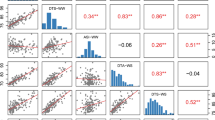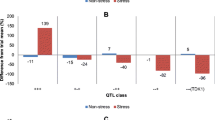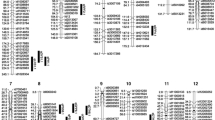Abstract
Drought is an important climatic phenomenon which, after soil infertility, ranks as the second most severe limitation to maize production in developing countries. When drought stress occurs just before or during the flowering period, a delay in silking is observed, resulting in an increase in the length of the anthesis-silking interval (ASI) and in a decrease in grain yield. Selection for reduced ASI in tropical open-pollinated varieties has been shown to be correlated with improved yields under drought stress. Since efficient selection for drought tolerance requires carefully managed experimental conditions, molecular markers were used to identify the genomic segments responsible for the expression of ASI, with the final aim of developing marker-assisted selection (MAS) strategies. An F2population of 234 individuals was genotyped at 142 loci and F3 families were evaluated in the field under several water regimes for male flowering (MFLW), male sterility (STER), female flowering (FFLW) and ASI. The genetic variance of ASI increased as a function of the stress intensity, and the broad-sense heritabilites of MFLW, FFLW and ASI were high under stress conditions, being 86%, 82% and 78%, respectively. Putative quantitative trait loci (QTLs) involved in the expression of MFLW and/or FFLW under drought were detected on chromosomes 1, 2, 4, 5, 8, 9 and 10, accounting for around 48% of the phenotypic variance for both traits. For ASI, six putative QTLs were identified under drought on chromosomes 1, 2, 5, 6, 8 and 10, and together accounted for approximately 47% of the phenotypic variance. Under water stress conditions, four QTLs were common for the expression of MFLW and FFLW, one for the expression of ASI and MFLW, and four for the expression of ASI and FFLW. The number of common QTLs for two traits was related to the level of linear correlation between these two traits. Segregation for ASI was found to be transgressive with the drought-susceptible parent contributing alleles for reduced ASI (4 days) at two QTL positions. Alleles contributed by the resistant line at the other four QTLs were responsible for a 7-day reduction of ASI. These four QTLs represented around 9% of the linkage map, and were stable over years and stress levels. It is argued that MAS based on ASI QTLs should be a powerful tool for improving drought tolerance of tropical maize inbred lines.
Similar content being viewed by others
References
Abler BSB, Edwards MD, Stuber CW (1991) Isoenzymatic identification of quantitative trait loci in crosses of elite maize inbreds. Crop Sci 31:267–274
Beavis WD, Smith OS, Grant D, Fincher R (1994) Identification of quantitative trait loci using a small sample of topcrossed and F4 progeny from maize. Crop Sci 34:882–896
Bolaños J, Edmeades GO (1993) Eight cycles of selection for drought tolerance in lowland tropical maize. II. Responses in reproductive behavior. Field Crops Res 31:253–268
Bolanos J, Edmeades GO, Martinez L (1993) Eight cycles of selection for drought tolerance in lowland tropical maize. III. Responses in drought-adaptive physiological and morphological traits. Field Crops Res 31:269–286
Bonnett OT (1960) The developmental anatomy of the corn plant. In: Heckendorn W, Blankenship BR (eds) Proc 15th Annual Hybrid Corn Ind Res Conf, ASTA, Chicago, pp 40–47
Burr B, Burr FA (1991) Recombinant inbreds for molecular mapping in maize: theoretical and practical considerations. Trends Genet 7:55–60
Burr B, Burr FA, Thompson KH, Albertson MC, Stuber CW (1988) Gene mapping with recombinant inbreds in maize. Genetics 118:519–526
Coe EHJ, Neuffer MG, Hoisington DA (1988) The genetics of corn. In: Sprague GF, Dudley JW (eds) Corn and corn improvement. American Society of Agronomy, Madison, Wisconsin, pp 81–258
Du Plessis DP, Dijkhuis FJ (1967) The influence of the time lag between pollen-shedding and silking on the yield of maize. S Afr J Agric Sci 10:667–674
Edmeades GO, Bolaños J, Lafitte HR (1992) Progress in breeding for drought tolerance in maize. In: Wilkinson D (eds) Proc 47th Annual Corn and Sorghum Res Conf, ASTA, Washington, pp 93–111
Edwards MD, Stuber CW, Wendel JF (1987) Molecular-markerfacilitated investigations of quantitative-trait loci in maize. I. Numbers, genomic distribution and types of gene action. Genetics 116:113–125
Edwards MD, Helentjaris T, Wright S, Stuber CW (1992) Molecular-marker-facilitated investigations of quantitative trait loci in maize. 4. Analysis based on genome saturation with isozyme and restriction fragment length polymorphism markers. Theor Appl Genet 83:765–774
Gardiner JM, Coe EH, Melia-Hancock S, Hoisington DA, Chao S (1993) Development of a core RFLP map in maize using an immortalized F2population. Genetics 134:917–930
Hall AJ, Lemcoff JH, Trapani N (1981) Water stress before and during flowering in maize and its effects on yield, its components, and their determinants. Maydica 26:19–38
Hall AJ, Vilella F, Trapani N, Chimenti C (1982) The effects of water stress and genotype on the dynamics of pollen-shedding and silking in maize. Field Crops Res 5:349–363
Helentjaris T, Slocum M, Wright S, Schaefer A, Nienhuis J (1986) Construction of genetic linkage maps in maize and tomato using restriction fragment length polymorphisms. Theor Appl Genet 72:761–769
Herrero MP, Johnson RR (1981) Drought stress and its effects on maize reproductive systems. Crop Sci 21:105–110
Hoisington DA, Khairallah M, González-de-León D (1994) Laboratory protocols: CIMMYT Applied Molecular Genetics Laboratory. CIMMYT (eds), CIMMYT, Mexico
Lande R, Thompson R (1990) Efficiency of marker-assisted selection in the improvement of quantitative traits. Genetics 124: 743–756
Lander ES, Botstein D (1989) Mapping Mendelian factors underlying quantitative traits using RFLP linkage maps. Genetics 121: 185–199
Lander ES, Green P, Abrahamson J, Barlow A, Daly MJ, Lincoln SE, Newburg L (1987) MAPMAKER: an interactive computer package for constructing primary genetic linkage maps of experimental and natural populations. Genomics 1:174–181
Maize Genetics Cooperation Newsletter (1994)
Mather K, Jinks JL (1971) Biometrical genetics. Chapman and Hall, London
Paterson AH, Lander ES, Hewitt JD, Peterson S, Lincoln SE, Tanksley SD (1988) Resolution of quantitative traits into Mendelian factors by using a complete linkage map of restriction fragment length polymorphisms. Nature 335:721–726
Paterson AH, Damon S, Hewitt JD, Zamir D, Rabinowitch HD, Lincoln SE, Lander ES, Tanksley SD (1991) Mendelian factors underlying quantitative traits in tomato: comparison across species, generations, and environments. Genetics 127:181–197
Phillips RL, Kim TS, Kaeppler SM, Parentoni SN, Shaver L, Stucker RE, Openshaw SJ (1992) Genetic dissection of maturity using RFLPs. In: Wilkinson D (eds) Proc 47th Annual Corn and Sorghum Res Conf, ASTA, Washington, pp 135–150
SAS Institute Incorporated (1988) SAS language guide for personal computers. Edition 6.03, Cary, North Carolina, USA
Stuber CW (1989) Molecular markers in the manipulation of quantitative characters. In: Brown AHD, Clegg MT, Kahler AL, Weir BS (eds) Plant population genetics, breeding, and genetic resources. Sinauer Associates, Sunderland, Massachusetts
Stuber CW, Moll RH, Goodman MM, Schaffer HE, Weir BS (1980) Allozyme frequency changes associated with selection for increased grain yield in maize (Zea mays L.). Genetics 95:225–236
Stuber CW, Goodman MM, Moll RH (1982) Improvement of yield and ear number resulting from selection at allozyme loci in a maize population. Crop Sci 22:737–740
Tanksley SD, Hewitt J (1988) Use of molecular markers in breeding for soluble solids content in tomato — a re-examination. Theor Appl Genet 75:811–823
Veldboom LR, Lee M, Woodman WL (1994) Molecular markerfacilitated studies in an elite maize population. I. Linkage analysis and determination of QTLs for morphological traits. Theor Appl Genet 88:7–16
Westgate ME, Bassetti P (1990) Heat and drought stress in corn: what really happens to the corn plant at pollination? In: D. Wilkinson (eds) Proc 45th Annual Corn and Sorghum Res Conf, ASTA, Washington, pp 12–28
Westgate ME, Boyer JS (1986) Reproduction at low silk and pollen water potentials in maize. Crop Sci 26:951–956
Zehr BE, Dudley JW, Rufener GK (1994) QTLs for degree of pollen-silk discordance, expression of disease lesion mimic, and leaf curl response to drought. Maize Genet Coop Newslett 68:110–111
Author information
Authors and Affiliations
Additional information
Communicated by G. E. Hart
Rights and permissions
About this article
Cite this article
Ribaut, J.M., Hoisington, D.A., Deutsch, J.A. et al. Identification of quantitative trait loci under drought conditions in tropical maize. 1. Flowering parameters and the anthesis-silking interval. Theoret. Appl. Genetics 92, 905–914 (1996). https://doi.org/10.1007/BF00221905
Received:
Accepted:
Issue Date:
DOI: https://doi.org/10.1007/BF00221905




